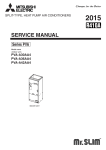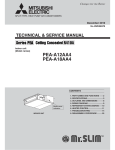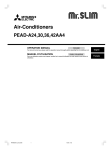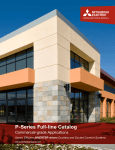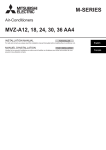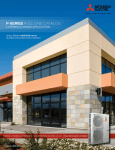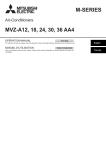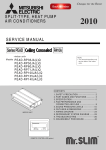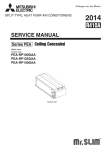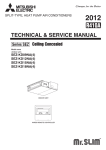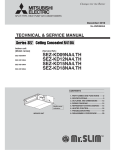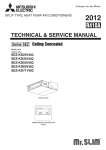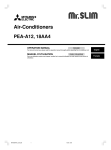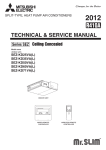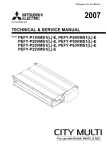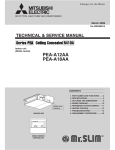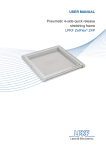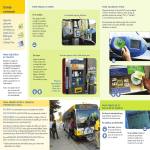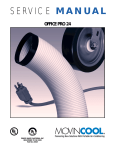Download SERVICE MANUAL
Transcript
SPLIT-TYPE, HEAT PUMP AIR CONDITIONERS
SERVICE MANUAL
Series MVZ
Model name
<Indoor unit>
MVZ-A12AA4
MVZ-A18AA4
MVZ-A24AA4
MVZ-A30AA4
MVZ-A36AA4
INDOOR UNIT
2015
CONTENTS
1. SAFETY PRECAUTION
2. PART NAMES AND FUNCTIONS
3. SPECIFICATION
4. FAN PERFORMANCE AND CORRECTED AIR FLOW
5. SOUND PRESSURE LEVELS
6. OUTLINES & DIMENSIONS
7. WIRING DIAGRAM
8. REFRIGERANT SYSTEM DIAGRAM
9. HEATER CONTROL
10. HUMIDIFIER CONTROL
11. ERV (ENERGY RECOVERY VENTILATION) CONTROL
12. TROUBLESHOOTING
13. DISASSEMBLY PROCEDURE
2
3
4
6
12
15
17
18
19
22
23
24
37
1 SAFETY PRECAUTION
1-1. ALWAYS OBSERVE FOR SAFETY
Before obtaining access to terminal, all supply
circuits must be disconnected.
1-2. CAUTIONS RELATED TO NEW REFRIGERANT
Cautions for units utilising refrigerant R410A
Use new refrigerant pipes.
Do not use refrigerant other than R410A.
In case of using the existing pipes for R22, be careful with
the followings.
· For A36 and A42, be sure to perform replacement operation before test run.
· Change flare nut to the one provided with this product.
Use a newly flared pipe.
· Avoid using thin pipes.
If other refrigerant (R22 etc.) is used, chlorine in refrigerant can cause deterioration of refrigerant oil etc.
Use a vacuum pump with a reverse flow check
valve.
Vacuum pump oil may flow back into refrigerant cycle and
that can cause deterioration of refrigerant oil etc.
Make sure that the inside and outside of refrigerant piping is clean and it has no contamination
such as sulfur hazardous for use, oxides, dirt,
shaving particles, etc.
In addition, use pipes with specified thickness.
Use the following tools specifically designed for
use with R410A refrigerant.
The following tools are necessary to use R410A refrigerant.
Gauge manifold
Charge hose
Gas leak detector
Torque wrench
Contamination inside refrigerant piping can cause deterioration of refrigerant oil etc.
Tools for R410A
Flare tool
Size adjustment gauge
Vacuum pump adaptor
Electronic refrigerant
charging scale
Store the piping to be used indoors during
installation and both ends of the piping sealed
until just before brazing. (Leave elbow joints, etc.
in their packaging.)
Handle tools with care.
If dirt, dust or moisture enters into refrigerant cycle, that can
cause deterioration of refrigerant oil or malfunction of compressor.
If dirt, dust or moisture enters into refrigerant cycle, that can
cause deterioration of refrigerant oil or malfunction of compressor.
Use ester oil, ether oil or alkylbenzene oil (small
amount) as the refrigerant oil applied to flares
and flange connections.
Do not use a charging cylinder.
If a charging cylinder is used, the composition of refrigerant will change and the efficiency will be lowered.
If large amount of mineral oil enters, that can cause deterioration of refrigerant oil etc.
Ventilate the room if refrigerant leaks during
operation. If refrigerant comes into contact with
a flame, poisonous gases will be released.
Charge refrigerant from liquid phase of gas
cylinder.
If the refrigerant is charged from gas phase, composition
change may occur in refrigerant and the efficiency will be
lowered.
[1] Cautions for service
(1) Perform service after recovering the refrigerant left in unit completely.
(2) Do not release refrigerant in the air.
(3) After completing service, charge the cycle with specified amount of refrigerant.
(4) When performing service, install a filter drier simultaneously.
Be sure to use a filter drier for new refrigerant.
[2] Additional refrigerant charge
When charging directly from cylinder
· Check that cylinder for R410A on the market is syphon type.
· Charging should be performed with the cylinder of syphon stood vertically. (Refrigerant is charged from liquid phase.)
2
Unit
Gravimeter
[3] Service tools
Use the below service tools as exclusive tools for R410A refrigerant.
No.
1
Tool name
Specifications
Gauge manifold
· Only for R410A
· Use the existing fitting specifications. (UNF1/2)
· Use high-tension side pressure of 5.3MPa·G or over.
2
Charge hose
· Only for R410A
· Use pressure performance of 5.09MPa·G or over.
3
Electronic scale
4
Gas leak detector
· Use the detector for R134a, R407C or R410A.
5
Adaptor for reverse flow check
· Attach on vacuum pump.
6
Refrigerant charge base
7
Refrigerant cylinder
8
Refrigerant recovery equipment
· Only for R410A
· Top of cylinder (Pink)
· Cylinder with syphon
2 PART NAMES AND FUNCTIONS
• Indoor Unit
(1)Vertical
(2)Horizontal Right
Air outlet
Air
inlet
Air inlet
3
Air
outlet
(3)Horizontal left
(4)Down flow
Air inlet
Air
outlet
Air
inlet
Air outlet
3 SPECIFICATION
INDOOR UNIT
1 phase, 60Hz, 208/230V
15
3.00
Galvanized steel cabinet - Powder coated Slate Gray
Plate fin coil
Sirocco fan × 1
0.121
2.4
7.9-9.6-11.3 (280-340-400)
75-125-200 (0.30-0.50-0.80)
Remote controller & built-in
24-28-32
27-31-35
32-36-41
19.05 (3/4) FPT
432 (17)
548 (21-5/8)
1275 (50-1/4)
51 (113)
INDOOR UNIT
MVZ-A12AA4
Service Ref.
Power supply (phase, cycle, voltage)
Max. Fuse Size
A
Min. Circuit Ampacity
A
External finish
Heat exchanger
Fan (drive) × No.
Fan
Fan motor output
kW
F.L.A
Fan motor
Airflow (Low-Mid-High)
m3/min (CFM)
External static pressure
Pa (in.WG)
Operation control & Thermostat
75Pa (0.30 in.WG)
Sound pressure level
125Pa (0.50 in.WG)
(Low-Mid-High)
dB (A)
200Pa (0.80 in.WG)
Drain pipe
mm (in.)
Dimensions
W
mm (in.)
D
mm (in.)
H
mm (in.)
kg (lbs)
Weight
Service Ref.
Power supply (phase, cycle, voltage)
Max. Fuse Size
A
Min. Circuit Ampacity
A
External finish
Heat exchanger
Fan (drive) × No.
Fan
Fan motor output
kW
F.L.A
Fan motor
Airflow (Low-Mid-High)
m3/min (CFM)
External static pressure
Pa (in.WG)
Operation control & Thermostat
Sound pressure level
75Pa (0.30 in.WG)
(Low-Mid-High)
125Pa (0.50 in.WG)
dB (A)
200Pa (0.80 in.WG)
Drain pipe
mm (in.)
Dimensions
W
mm (in.)
D
mm (in.)
H
mm (in.)
kg (lbs)
Weight
1 phase, 60Hz, 208/230V
15
3.00
Galvanized Steel Cabinet - Powder coated Slate Gray
Plate fin coil
Sirocco fan × 1
0.121
2.4
11.6-14.1-16.6 (410-497-585)
75-125-200 (0.30-0.50-0.80)
Remote controller & built-in
26-30-34
28-32-36
33-37-41
19.05 (3/4) FPT
432 (17)
548 (21-5/8)
1275 (50-1/4)
51 (113)
MVZ-A18AA4
4
INDOOR UNIT
1 phase, 60Hz, 208/230V
15
3.00
Galvanized Steel Cabinet - Powder coated Slate Gray
Plate fin coil
Sirocco fan × 1
0.121
2.4
14.6-17.7-20.8 (515-625-735)
75-125-200 (0.30-0.50-0.80)
Remote controller & built-in
28-33-36
30-34-38
34-38-42
19.05 (3/4) FPT
432 (17)
548 (21-5/8)
1275 (50-1/4)
51 (113)
INDOOR UNIT
Service Ref.
Power supply (phase, cycle, voltage)
Max. Fuse Size
A
Min. Circuit Ampacity
A
External finish
Heat exchanger
Fan (drive) × No.
Fan
Fan motor output
kW
F.L.A
Fan motor
Airflow (Low-Mid-High)
m3/min (CFM)
External static pressure
Pa (in.WG)
Operation control & Thermostat
Sound pressure level
75Pa (0.30 in.WG)
(Low-Mid-High)
125Pa (0.50 in.WG)
dB (A)
200Pa (0.80 in.WG)
Drain pipe
mm (in.)
Dimensions
W
mm (in.)
D
mm (in.)
H
mm (in.)
kg (lbs)
Weight
1 phase, 60Hz, 208/230V
15
4.13
Galvanized Steel Cabinet - Powder coated Slate Gray
Plate fin coil
Sirocco fan × 1
0.244
3.3
17.3-21.1-24.8 (613-744-875)
75-125-200 (0.30-0.50-0.80)
Remote controller & built-in
30-34-38
32-36-40
35-39-43
19.05 (3/4) FPT
534 (21)
548 (21-5/8)
1378 (54-1/4)
64 (141)
INDOOR UNIT
MVZ-A24AA4
Service Ref.
Power supply (phase, cycle, voltage)
Max. Fuse Size
A
Min. Circuit Ampacity
A
External finish
Heat exchanger
Fan (drive) × No.
Fan
Fan motor output
kW
F.L.A
Fan motor
Airflow (Low-Mid-High)
m3/min (CFM)
External static pressure
Pa (in.WG)
Operation control & Thermostat
Sound pressure level
75Pa (0.30 in.WG)
(Low-Mid-High)
125Pa (0.50 in.WG)
dB (A)
200Pa (0.80 in.WG)
Drain pipe
mm (in.)
Dimensions
W
mm (in.)
D
mm (in.)
H
mm (in.)
kg (lbs)
Weight
Service Ref.
Power supply (phase, cycle, voltage)
Max. Fuse Size
A
Min. Circuit Ampacity
A
External finish
Heat exchanger
Fan (drive) × No.
Fan
Fan motor output
kW
F.L.A
Fan motor
Airflow (Low-Mid-High)
m3/min (CFM)
External static pressure
Pa (in.WG)
Operation control & Thermostat
Sound pressure level
75Pa (0.30 in.WG)
(Low-Mid-High)
125Pa (0.50 in.WG)
dB (A)
200Pa (0.80 in.WG)
Drain pipe
mm (in.)
Dimensions
W
mm (in.)
D
mm (in.)
H
mm (in.)
kg (lbs)
Weight
1 phase, 60Hz, 208/230V
15
4.13
Galvanized Steel Cabinet - Powder coated Slate Gray
Plate fin coil
Sirocco fan × 1
0.244
3.3
21.7-26.4-31.0 (767-931-1095)
75-125-200 (0.30-0.50-0.80)
Remote controller & built-in
33-37-41
35-39-43
37-41-45
19.05 (3/4) FPT
534 (21)
548 (21-5/8)
1378 (54-1/4)
64 (141)
MVZ-A30AA4
MVZ-A36AA4
5
4 FAN PERFORMANCE AND CORRECTED AIR FLOW
MVZ-A12AA4
• Vertical, Horizontal Right, Horizontal Left
• Downflow
External static pressure 0.30 [in.WG] (75Pa) 208/230V 60Hz
External static pressure 0.30 [in.WG] (75Pa) 208/230V 60Hz
100
[0.40]
100
[0.40]
75
[0.30]
High
Static pressure (Pa)[in.WG]
Static pressure (Pa)[in.WG]
75
[0.30]
Middle
50
[0.20]
Low
25
[0.10]
High
50
[0.20]
Middle
Low
25
[0.10]
0
[0] 7
[247]
10
[353]
0
[0] 7
[247]
14
[494]
10
[353]
Airflow rate (m3/min)[cfm]
External static pressure 0.50 [in.WG] (125Pa) 208/230V 60Hz
External static pressure 0.50 [in.WG] (125Pa) 208/230V 60Hz
150
[0.60]
150
[0.60]
125
[0.50]
125
[0.50]
High
High
Static pressure (Pa)[in.WG]
Static pressure (Pa)[in.WG]
14
[494]
Airflow rate (m3/min)[cfm]
100
[0.40]
Middle
100
[0.40]
Middle
75
[0.30]
Low
75
[0.30]
50
[0.20]
Low
50
[0.20] 7
[247]
10
[353]
25
[0.10] 7
[247]
14
[494]
10
[353]
Airflow rate (m3/min)[cfm]
External static pressure 0.80 [in.WG] (200Pa) 208/230V 60Hz
External static pressure 0.80 [in.WG] (200Pa) 208/230V 60Hz
225
[0.90]
225
[0.90]
200
[0.80]
High
175
[0.70]
Static pressure (Pa)[in.WG]
Static pressure (Pa)[in.WG]
200
[0.80]
150
[0.60]
Middle
125
[0.50]
100
[0.40]
75
[0.30] 7
[247]
14
[494]
Airflow rate (m3/min)[cfm]
175
[0.70]
150
[0.60]
Middle
125
[0.50]
100
[0.40]
Low
10
[353]
75
[0.30] 7
[247]
14
[494]
Airflow rate (m3/min)[cfm]
High
Low
10
[353]
Airflow rate (m3/min)[cfm]
6
14
[494]
MVZ-A18AA4
• Vertical, Horizontal Right, Horizontal Left
• Downflow
External static pressure 0.30 [in.WG] (75Pa) 208/230V 60Hz
External static pressure 0.30 [in.WG] (75Pa) 208/230V 60Hz
100
[0.40]
100
[0.40]
75
[0.30]
High
Static pressure (Pa)[in.WG]
Static pressure (Pa)[in.WG]
75
[0.30]
Middle
50
[0.20]
High
50
[0.20]
Middle
Low
Low
25
[0.10]
25
[0.10]
0
[0] 10
[353]
15
[530]
0
[0] 10
[353]
20
[706]
15
[530]
Airflow rate (m3/min)[cfm]
External static pressure 0.50 [in.WG] (125Pa) 208/230V 60Hz
External static pressure 0.50 [in.WG] (125Pa) 208/230V 60Hz
150
[0.60]
150
[0.60]
125
[0.50]
125
[0.50]
High
High
Static pressure (Pa)[in.WG]
Static pressure (Pa)[in.WG]
20
[706]
Airflow rate (m3/min)[cfm]
100
[0.40]
Middle
75
[0.30]
100
[0.40]
Middle
75
[0.30]
Low
50
[0.20]
Low
50
[0.20]
10
[353]
15
[530]
25
[0.10] 10
[353]
20
[706]
15
[530]
External static pressure 0.80 [in.WG] (200Pa) 208/230V 60Hz
External static pressure 0.80 [in.WG] (200Pa) 208/230V 60Hz
225
[0.90]
225
[0.90]
200
[0.80]
High
175
[0.70]
Static pressure (Pa)[in.WG]
Static pressure (Pa)[in.WG]
200
[0.80]
150
[0.60]
Middle
125
[0.50]
100
[0.40]
20
[706]
Airflow rate (m3/min)[cfm]
Airflow rate (m3/min)[cfm]
High
175
[0.70]
150
[0.60]
Middle
125
[0.50]
100
[0.40]
Low
Low
75
[0.30] 10
[353]
15
[530]
75
[0.30] 10
[353]
20
[706]
Airflow rate (m3/min)[cfm]
15
[530]
Airflow rate (m3/min)[cfm]
7
20
[706]
MVZ-A24AA4
• Vertical, Horizontal Right, Horizontal Left
• Downflow
External static pressure 0.30 [in.WG] (75Pa) 208/230V 60Hz
External static pressure 0.30 [in.WG] (75Pa) 208/230V 60Hz
100
[0.40]
100
[0.40]
75
[0.30]
High
50
[0.20]
Static pressure (Pa)[in.WG]
Static pressure (Pa)[in.WG]
75
[0.30]
Middle
Low
High
50
[0.20]
Middle
Low
25
[0.10]
25
[0.10]
0
[0] 13
[459]
15
[530]
20
[706]
0
[0] 13
[459]
24
[847]
15
[530]
Airflow rate (m3/min)[cfm]
External static pressure 0.50 [in.WG] (125Pa) 208/230V 60Hz
24
[847]
External static pressure 0.50 [in.WG] (125Pa) 208/230V 60Hz
150
[0.60]
150
[0.60]
125
[0.50]
125
[0.50]
High
High
Static pressure (Pa)[in.WG]
Static pressure (Pa)[in.WG]
20
[706]
Airflow rate (m3/min)[cfm]
100
[0.40]
Middle
100
[0.40]
Middle
75
[0.30]
Low
75
[0.30]
50
[0.20]
Low
50
[0.20] 13
[459]
15
[530]
20
[706]
25
[0.10] 13
[459]
24
[847]
15
[530]
20
[706]
24
[847]
Airflow rate (m3/min)[cfm]
Airflow rate (m3/min)[cfm]
External static pressure 0.80 [in.WG] (200Pa) 208/230V 60Hz
External static pressure 0.80 [in.WG] (200Pa) 208/230V 60Hz
225
[0.90]
225
[0.90]
High
High
200
[0.80]
175
[0.70]
Static pressure (Pa)[in.WG]
Static pressure (Pa)[in.WG]
200
[0.80]
150
[0.60]
Middle
125
[0.50]
100
[0.40]
75
[0.30] 13
[459]
175
[0.70]
150
[0.60]
Middle
125
[0.50]
100
[0.40]
Low
Low
15
[530]
20
[706]
75
[0.30] 13
[459]
22
[777]
Airflow rate (m3/min)[cfm]
15
[530]
20
[706]
Airflow rate (m3/min)[cfm]
8
22
[777]
MVZ-A30AA4
• Vertical, Horizontal Right, Horizontal Left
• Downflow
External static pressure 0.30 [in.WG] (75Pa) 208/230V 60Hz
External static pressure 0.30 [in.WG] (75Pa) 208/230V 60Hz
100
[0.40]
100
[0.40]
High
High
75
[0.30]
Static pressure (Pa)[in.WG]
Static pressure (Pa)[in.WG]
75
[0.30]
Middle
50
[0.20]
Low
50
[0.20]
Middle
Low
25
[0.10]
25
[0.10]
0
[0] 15
[530]
20
[706]
25
[883]
0
[0] 15
[530]
29
[1024]
20
[706]
Airflow rate (m3/min)[cfm]
25
[883]
29
[1024]
Airflow rate (m3/min)[cfm]
External static pressure 0.50 [in.WG] (125Pa) 208/230V 60Hz
External static pressure 0.50 [in.WG] (125Pa) 208/230V 60Hz
150
[0.60]
150
[0.60]
High
125
[0.50]
High
Static pressure (Pa)[in.WG]
Static pressure (Pa)[in.WG]
125
[0.50]
100
[0.40]
Middle
75
[0.30]
100
[0.40]
Middle
75
[0.30]
Low
Low
50
[0.20]
50
[0.20]
25
[0.10]
15
[530]
20
[706]
25
[883]
25
[0.10] 15
[530]
29
[1024]
20
[706]
25
[883]
28
[989]
Airflow rate (m3/min)[cfm]
Airflow rate (m3/min)[cfm]
External static pressure 0.80 [in.WG] (200Pa) 208/230V 60Hz
External static pressure 0.80 [in.WG] (200Pa) 208/230V 60Hz
225
[0.90]
225
[0.90]
High
200
[0.80]
High
175
[0.70]
Static pressure (Pa)[in.WG]
Static pressure (Pa)[in.WG]
200
[0.80]
150
[0.60]
Middle
125
[0.50]
100
[0.40]
175
[0.70]
150
[0.60]
125
[0.50]
100
[0.40]
Low
75
[0.30]
15
[530]
20
[706]
25
[883]
29
[1024]
Airflow rate (m3/min)[cfm]
Middle
75
[0.30] 15
[530]
Low
20
[706]
Airflow rate (m3/min)[cfm]
9
25
[883]
27
[953]
MVZ-A36AA4
• Vertical, Horizontal Right, Horizontal Left
• Downflow
External static pressure 0.30 [in.WG] (75Pa) 208/230V 60Hz
External static pressure 0.30 [in.WG] (75Pa) 208/230V 60Hz
100
[0.40]
125
[0.50]
High
100
[0.40]
High
Static pressure (Pa)[in.WG]
Static pressure (Pa)[in.WG]
75
[0.30]
Middle
50
[0.20]
Low
75
[0.30]
Middle
50
[0.20]
Low
25
[0.10]
25
[0.10]
0
[0] 19
20
[671] [706]
25
[883]
30
[1059]
0
[0] 19
20
[671] [706]
33
[1165]
25
[883]
Airflow rate (m3/min)[cfm]
30
[1059]
32
[1130]
Airflow rate (m3/min)[cfm]
External static pressure 0.50 [in.WG] (125Pa) 208/230V 60Hz
External static pressure 0.50 [in.WG] (125Pa) 208/230V 60Hz
150
[0.60]
175
[0.70]
150
[0.60]
High
High
Static pressure (Pa)[in.WG]
Static pressure (Pa)[in.WG]
125
[0.50]
100
[0.40]
Middle
125
[0.50]
100
[0.40]
Middle
75
[0.30]
Low
75
[0.30]
50
[0.20]
Low
50
[0.20] 19
20
[671] [706]
25
[883]
30
[1059]
25
[0.10] 19
20
[671] [706]
32
[1130]
25
[883]
30
[1059]
32
[1130]
Airflow rate (m3/min)[cfm]
Airflow rate (m3/min)[cfm]
External static pressure 0.80 [in.WG] (200Pa) 208/230V 60Hz
External static pressure 0.60 [in.WG] (150Pa) 208/230V 60Hz
225
[0.90]
200
[0.80]
High
200
[0.80]
175
[0.70]
175
[0.70]
150
[0.60]
Static pressure (Pa)[in.WG]
Static pressure (Pa)[in.WG]
High
Middle
125
[0.50]
100
[0.40]
75
[0.30]
19
20
[671] [706]
150
[0.60]
125
[0.50]
100
[0.40]
75
[0.30]
Low
25
[883]
30
[1059]
32
[1130]
Airflow rate (m3/min)[cfm]
Middle
50
[0.20]
19
20
[671] [706]
Low
25
[883]
Airflow rate (m3/min)[cfm]
10
30
[1059]
32
[1130]
MVZ-A12, 18, 24, 30, 36AA4
Air filter
Power source:208/230V 60Hz
25
[0.100]
External static pressure (Pa)[in.WG]
20
[0.080]
A30,36
15
[0.060]
A12,18,24
10
[0.040]
5
[0.020]
0
[0] 0
[0]
10
[353]
20
[706]
Airflow rate
30
[1059]
40
[1412]
50
[1766]
(m3/min)[cfm]
11
5 SOUND PRESSURE LEVELS
5-1. Sound pressure level
Ceiling concealed
5-2. NC curves
MVZ-A12AA4
MVZ-A18AA4
- ./01 "2%
#&'
(
+
+
! "#$%
+
,+
- ./01 " 2%
#&'
(
+
+
! "#$%
+
,+
- ./01 " 2%
)*
#&'
(
)*
+
+
! "#$%
+
#&'
(
,+
- , ./01 "2%
+
+
! "#$%
+
,+
- , ./01 "2%
)*
#&'
(
)*
)*
#&'
(
- ./01 "2%
)*
+
+
! "#$%
+
,+
12
+
+
! "#$%
+
,+
MVZ-A24AA4
MVZ-A30AA4
% $# $$! & '() *+,
.
.
/# " # 01! #$ *2,
.
!
!" # !!$ $
-.
% $# $$! & '() * +,
!
!" # !!$ $
.
.
/# " # 01! #$ *2,
.
-.
% $# $$! & '() * +,
!
!" # !!$ $
% $# $$! & '() *+,
.
.
/# " # 01! #$ *2,
.
!
!" # !!$ $
-.
.
.
/# " # 01! #$ *2,
.
-.
% $# $$! - & '() *+,
% $# $$! - & '() *+,
!
!" # !!$ $
!
!" # !!$ $
.
.
/# " # 01! #$ *2,
.
-.
13
.
.
/# " # 01! #$ *2,
.
-.
MVZ-A36AA4
! "#$% &'(
+ , ,,!,
!- , !! *
*
./ - 01! &2(
*
)*
! "#$% & '(
+ , ,,!,
!- , !! *
*
./ - 01! &2(
*
)*
! ) "#$% &'(
+ , ,,!,
!- , !! *
*
./ - 01! &2(
*
)*
14
Model
MVZ-A12AA4
MVZ-A18AA4
MVZ-A24AA4
MVZ-A30AA4
MVZ-A36AA4
Left side
view
B
C
70(2-13/16)
55(2-3/16)
D
E
F
Air filter
G
Bottom
view
3
55(2-3/16)
Secondary drain pipe
(Emergency draining)
ø19.05(3/4) 3/4"FPT
43(1-3/4)
92(3-5/8)
461
(18-3/16)
382.6 266.5 1378
737
953.5
477
792
534
(21) (18-13/16) (15-1/8) (10-1/2) (54-1/4) (29-1/16) (37-9/16) (31-3/16)
J
360
(14-3/16)
H
J
A
1
(3/8)
Liquid pipe
ø6.35
(1/4)
ø9.52
2
(5/8)
Gas pipe
ø12.7
(1/2)
36.8(1-1/2)
Primary drain pipe
(Gravity drain)
ø19.05(3/4) 3/4"FPT
Secondary drain pipe
(Emergency draining)
ø19.05(3/4) 3/4"FPT
(Horizontal Right)
Terminal block
(Remote controller transmission)
Terminal block
(Indoor / Outdoor unit connection)
Control box
43(1-3/4)
Primary drain pipe
(Gravity drain)
ø19.05(3/4) 3/4"FPT
28.8(1-3/16)
76(3)
D
Unit:mm(in.)
Model
MVZ-A12AA4
MVZ-A18AA4
MVZ-A24AA4
MVZ-A30AA4
MVZ-A36AA4
Bottom
3
Right side
view
548(21-5/8)
402(15-7/8)
(Duct)
508X508X25.4
(20X20X1)
508X406.4X25.4
(20X16X1)
477X402
(18-13/16X15-7/8)
376X402
(14-13/16X15-7/8)
Nominal Filter Size Duct Connection
ø26 Knockout Hole
(Remote controller
transmission)
Top
Front
view
117.4 (4-5/8)
Note 1.Keep the service space for maintenance at the front.
ø26 Knockout Hole
(Remote controller transmission)
ø15.88
Air inlet
8(3/8)
30(1-3/16)
8(3/8)
B(Duct)
C
Air outlet
735.5
(29)
376
281
224 1275
680
823
432
(17) (14-13/16) (11-1/8) (8-7/8) (50-1/4) (26-13/16) (32-7/16)
A
66(2-5/8)
77.8(3-1/8)
ø19.05(3/4) 3/4"FPT
Primary drain pipe
(Gravity drain)
ø19.05(3/4) 3/4"FPT
(Horizontal left)
2-ø4.6 Burring Holes
for electric heat installation
1 Refrigerant piping
brazing connection(gas)
2 Refrigerant piping
brazing connection(liquid)
ø26 Knockout Hole
(Indoor / Outdoor
Secondary drain pipe
(Emergency draining)
unit connection)
ø26 Knockout Hole
(Indoor / Outdoor unit
connection)
50.8(2)
15
470(18-9/16)
G
H
13.2(9/16)
55(2-3/16)
525.5(20-3/4) 8(3/8)
F
24(15/16)
E
Top
view
6 OUTLINES & DIMENSIONS
INDOOR UNIT
MVZ-A12, 18, 24, 30, 36AA4
16
Length of Unit
Horizontal Installation
Vertical Installation
609.6(24)
Width of Unit
Clearance Area
Unit:mm(in.)
609.6(24)
7 WIRING DIAGRAM
MVZ-A12, 18, 24, 30, 36AA4
RFI
TRANSMISSION
WIRES DC 12V
INSIDE SECTION OF CONTROL BOX
TB15
1
2
TB6
1
2
R.B.
LED2
SW2
OFF
(RED)
5 CND
DSA
MVZ-A24AA4
123456789
CN1
BZ1
MVZ-A30AA4
LED1
RU
SW1 SW2
W.B.
OPTIONAL PARTS
t˚
t˚
TH2 TH5
MVZ-A36AA4
t˚
TH1
12345
ON
12345
ON
12345
ON
12345
ON
12345
SWITCH
ON
12345
ON
12345
ON
12345
ON
12345
ON
12345
SW5
MVZ-A18AA4
ON
SW5
CNMF
7654
1
MODEL
MVZ-A12AA4
SW5
CNXB1
12345
(BLUE)
CNXC1 CNXA1
1234
12
DC280-340V
RECTIFIER CIRCUIT
SW5
X10
SW2
CNXC2 1
2
1
3
2
4
SW5
U
(BLUE)
LED1 CNXA2
SW2
CNXB2
1
2
3
4
5
SW2
(RED)
CN2L
ZNR01
SW2
(RED) (YELLOW)
CN20 CN24-1
1
2
F01
U
ZNR02
CN51
SW2
CN44 CN4F
1
1
2
2
3
3
4
4
(BLUE) 2
CN22 1
SW1
(BLACK) (BLUE)
CN2C CN24-2
LED3
CN25
SW1
(RED)
CNER
(GREEN)
CNF
3
CN41
SWE
ON
1
SW1
SW5
P.B.
(BLACK)
CN2A
SW1
1
2
3
4
5
6
7
8
9
OPTIONAL PARTS
TO OUTDOOR UNIT
SW1
CN90
S1
S2
S3
5
(RED) 43
CN105 2
1
CN32
1 (BLUE) SW1
3 CN3C
REMOTE CONTROLLER
TB4
I.B.
ON
12345678
ON
12345678
ON
12345678
ON
12345678
ON
12345678
MS
3~
FAN MOTOR
SYMBOL EXPLANATION
SYMBOL
NAME
SYMBOL
NAME
SYMBOL
NAME
I.B.
OPTIONAL PARTS
INDOOR CONTROLLER BOARD
INDOOR CONTROLLER BOARD
I.B.
W.B.
CN24-1 CONNECTOR (HEATER CONTROL 1ST)
SW1
SWITCH (FOR MODEL SELECTION)
IR WIRELESS REMOTE CONTROLLER BOARD
RU RECEIVING UNIT
CN24-2 CONNECTOR (HEATER CONTROL 2ND)
SW2
SWITCH (FOR CAPACITY CODE)
BZ1 BUZZER
CN25 CONNECTOR (HUMIDITY OUTPUT)
SW5
SWITCH (FOR MODE SELECTION)
LED1 LED(RUN INDICATOR)
CN2A CONNECTOR (0-10V ANALOG INPUT)
SWE
CONNECTOR (EMERGENCY OPERATION)
P.B.
SW1 SWITCH(HEATING ON/OFF)
CN2C CONNECTOR (ERV OUTPUT)
POWER SUPPLY BOARD
SW2
CN2L CONNECTOR (LOSSNAY)
F01
FUSE AC250V 6.3A
SWITCH(COOLING ON/OFF)
R.B.
CN32 CONNECTOR (REMOTE SWITCH)
ZNR01,02 VARISTOR
WIRED REMOTE CONTROLLER BOARD
DSA
CN41 CONNECTOR (HA TERMINAL-A)
ARRESTOR
TB6 TERMINAL BLOCK
(REMOTE CONTROLLER TRANSMISSION LINE)
X10
CN51 CONNECTOR (CENTRALLY CONTROL)
AUX.RELAY
TH1
CN90 CONNECTOR (WIRELESS)
INTAKE AIR TEMP. THERMISTOR
TH2
CN105 CONNECTOR (RADIO FREQUENCY INTERFACE)
PIPE TEMP. THERMISTOR/LIQUID
TH5
CNER CONNECTOR (ERV INPUT)
COND./EVA.TEMP. THERMISTOR
CNF CONNECTOR (HUMIDITY INPUT)
TERMINAL BLOCK
TB4
(INDOOR/OUTDOOR CONNECTING LINE)
LED1 LED(POWER SUPPLY)
LED2 LED(REMOTE CONTROLLER SUPPLY)
TERMINAL BLOCK
TB15
(REMOTE CONTROLLER TRANSMISSION LINE)
LED3 LED(TRANSMISSION INDOOR-OUTDOOR)
RFI
RADIO FREQUENCY INTERFACE FOR RF THERMOSTAT
17
Note1.Since the outdoor side electric wiring may change be sure
to check the outdoor unit electric wiring for servicing.
2.Indoor and outdoor connecting wires are made with
polarities,make wiring matching terminal numbers
(S1,S2,S3).
3.Symbols used in wiring diagram above are as follows.
:CONNECTOR
:TERMINAL
(HEAVY DOTTED LINE):FIELD WIRING
(THIN DOTTED LINE):OPTIONAL PARTS
4.Use copper supply wire.
UTILISER DES FILS D'ALIMENTATION EN CUIVRE.
8 REFRIGERANT SYSTEM DIAGRAM
MVZ-A12, 18, 24, 30, 36AA4
Strainer (#50)
Heat exchanger
Refrigerant GAS pipe connection
(Flare)
Thermistor TH5
(Cond./ Eva.temperature)
Refrigerant flow in cooling
Refrigerant flow in heating
Thermistor TH2
Pipe temperature(Liquid)
Refrigerant LIQUID pipe connection
(Flare)
Thermistor TH1
(Room temperature)
Distributor
with strainer (#50)
Strainer (#50)
18
9 HEATER CONTROL
9-1. CONTROL SPECIFICATIONS AND FUNCTION SETTING
Table 1 shows how the field-installed heater is controlled. Select the desired pattern in the table below, and set the
Function on the indoor units as shown in Table 1.
Table.1 [Function table]
Select unit numbers 01 to 03 or all units (AL [wired remote controller] / 07 [IR wireless remote controller])
'& & (
(
) #"*+
*+!
4 , % % % -.'(,/ -'(/
$
'& (
(
) #0+
+!
4 , % % % -.'(,/ $
(
(
) #1+
*+!
4 , % % % -.'(,/ $
'& $ (
#0+
+!
(
) #2+
+!
4 , % % % -.'(,/ $
#0+
+!
(
) #"*+
*+!
4 , % % % -.'(,/ $
!"#
$% &
!"#
& &
3 19
9-2. FAN CONTROL
By setting the Mode No. 23 in the Function Table in section 9-1, the following patterns of fan control will become possible.
Fan control patterns
CN4Y for FAN control
(PAC-YU25HT)
Mode(function)
No.23(123)
Fan in defrost
Fan(All modes other
than defrost)
Disabled
(CN4Y cannot be used with this unit)
1
STOP(Heater OFF)
Set(Heater ON*2)
2
STOP(Heater OFF)
High*1(Heater ON*2)
Factory
setting
-
*1 While the heater is on, the fan will operate at high speed regardless of the fan setting on the remote controller.
*2 While the heater output is on in the Function Table in section 9-1, the heater will be ON except when the unit is in
communication error, return air thermistor error and motor error.
* If a heater is installed in the duct, do not use Panel heater connector. By doing so, the fan will turn off
when the heater is on, which may result in fire.
9-3. PAC-YU25HT (OPTIONAL PARTS) INSTALLATION
The following section describes installation of the External Heater Adapter that connects to MVZ-A AA4
series indoor unit. This products is the special wiring parts to drive an electric heater with the air conditioner.
(1) Parts list
Check that the following parts are included in the package.
1) External output cable (with a yellow connector).............................2 in total
Two types of cables with different connectors are included.
2) Panel heater connector.................................................................. 3 in total
White: 1
Green: 2 (2 types)
*Panel heater connectors cannot be used with this unit.
(2) Connection to the indoor unit
Use the cables that fit the connectors on the indoor unit control board.
1) External output cable (with a yellow connector)
This cable is used to connect a relay circuit for an interlocked operation with either an electric or a panel heater.
Select the heater output pattern (1st = CN24-1 or 2nd = CN24-2) to use, and connect the cable to the connector
on the indoor unit control board that corresponds to the selection.
20
(3) Locally procured wiring
A basic connection method is shown below.
Electric Heater
power source
Remote control board
Relay circuit
Indoor unit
control board
Adapter
1
White
2
X
Yellow
CN24-1 or CN24-2
Red
X
Electric Heater
or panel
heater
Maximum cable length
is 10 m (32ft)
Preparations in the field
For relay X use the specifications given below Operation coil
Rated voltage: 12VDC
Power consumption: 0.9W or less
* Use the diode that is recommended by the relay manufacturer at both ends of the relay coil.
The length of the electrical wiring for the PAC-YU25HT is 2 meters (6-1/2 ft.)
To extend this length, use sheathed 2-core cable.
Control cable type: CVV, CVS, CPEV or equivalent.
Cable size: 0.5 mm2 ~ 1.25 mm2 (16 to 22 AWG)
Don't extend the cable more than 10 meters (32ft)
Recommended circuit
FS1
H1
88H
FS2
FS1
H2
88H
FS2
R
Wiring diagram
1-phase
power supply
S
208V, 230V/60Hz
R
S
FS1, 2 ----- Thermal fuse
26H
88H
Control board
H1, H2 ----- Heater
26H --------- Overheat
protection thermostat
88H --------- Electromagnetic contactor
CN24-1 or CN24-2
(4) Wiring restrictions
Keep the length of the cable connecting to the circuit board of the indoor unit shorter than 10 meters (32ft).
Longer than 10 meters (32ft) could cause improper operation.
Use a transit relay when extending wiring such as remote wiring.
21
10 HUMIDIFIER CONTROL
10-1. CONTROL SPECIFICATIONS
The below table shows how the field installed humidifier and fan speed is controlled.
Mode (function) No. Humidistat
Wired remote controller output
(RF thermostat)
13 (113) 16 (116) CNF input
OFF
1
2
ON
2
OFF
ON
Condition (no defrost/no error)
CN25 output
Fan speed
Heat operation & Thermo OFF
Heat operation & Thermo ON
Heat operation & Thermo OFF
Heat operation & Thermo ON
Heat operation & Thermo OFF
Heat operation & Thermo ON
Heat operation & Thermo OFF
Heat operation & Thermo ON
Except for heat operation
OFF
RC setting
OFF
ON
OFF
RC setting
High
RC setting
ON
High
OFF
RC:Remote controller
The fan continues to run for 30 seconds after the humidifier stops.
RC setting
10-2. INSTALLATION
A basic connection method is shown below.
Humidifier
power source
Indoor unit
control board
CN25
XA
XA
SVA
CNF
Humidifier
Humidistat
On-site preparation
Maximum cable length is 10m(32ft)
Use XA relay having following specifications
Rated voltage:12VDC
Power consumption:1W or less
Humidistat:Minimum applicable load 1mA at DC
Contact rating voltage:15VDC or more
Contact rating current:0.1A or more
22
11 ERV (ENERGY RECOVERY VENTILATION) CONTROL
11-1. CONTROL SPECIFICATIONS
The below table shows how the field installed ERV is controlled.
ERV output
CNER input
Condition
Fan speed
CN2C output
(=Fan output)
OFF
Cool/Heat/Fan operation
Defrost
STOP
Cool/Heat/Fan operation
Defrost
STOP
RC setting
STOP
STOP
RC setting
STOP
Low
ON
OFF
OFF
ON
OFF
ON
ON
11-2. INSTALLATION
A basic connection method is shown below.
Indoor unit
control board
ERV
power source
CN2C
XB
XB
XF
CNER
ERV
ERV switch
On-site preparation
Maximum cable length is 10m(32ft)
Use XB relay having following specifications
Rated voltage:12VDC
Power consumption:1W or less
ERV switch:Minimum applicable load 1mA at DC
Contact rating voltage:15VDC or more
Contact rating current:0.1A or more
23
12 TROUBLESHOOTING
12-1. CAUTIONS ON TROUBLESHOOTING
(1) Before troubleshooting, check the followings:
1 Check the power supply voltage.
2 Check the indoor/outdoor connecting wire for mis-wiring.
(2) Take care the followings during servicing.
1 Before servicing the air conditioner, be sure to turn off the remote controller first to stop the main unit, and then turn
off the breaker.
2 When removing the indoor controller board, hold the edge of the board with care NOT to apply stress on the
components.
3 When connecting or disconnecting the connectors, hold the housing of the connector. DO NOT pull the lead wires.
Lead wires
24
12-2. SELF-CHECK FUNCTION
• Refer to the installation manual that comes with each remote controller for details.
• RF thermostat is not established.
[Output pattern A] Errors detected by indoor unit
IR wireless remote controller
Beeper sounds/OPERATION
INDICATOR lamp flashes
(Number of times)
1
2
3
4
5
6
7
8
9
10
11
12
No sound
Wired remote controller
RF thermostat
Symptom
Remark
Check code
P1
P2, P9
E6, E7
P4
P5
P6
EE
P8
E4
–
–
Fb
––
Intake sensor error
Pipe (Liquid or 2-phase pipe) sensor error
Indoor/outdoor unit communication error
Drain sensor error
Drain pump error
Freezing/Overheating safeguard operation
Communication error between indoor and outdoor units
Pipe temperature error
Remote controller signal receiving error
–
–
Indoor unit control system error (memory error, etc.)
No corresponding
[Output pattern B] Errors detected by unit other than indoor unit (outdoor unit, etc.)
IR wireless remote controller
Wired remote controller
RF thermostat
Symptom
Beeper sounds/OPERATION
INDICATOR lamp flashes
(Number of times)
1
2
3
4
5
6
7
8
9
10
E9
UP
U3, U4
UF
U2
U1, Ud
U5
U8
U6
U7
11
U9, UH
12
13
14
–
–
Others
Remark
Check code
Indoor/outdoor unit communication error (Transmitting error) (Outdoor unit)
Compressor overcurrent interruption
Open/short of outdoor unit thermistors
Compressor overcurrent interruption (When compressor locked)
Abnormal high discharging temperature/49C worked/ insufficient refrigerant
Abnormal high pressure (63H worked)/ Overheating safeguard operation
Abnormal temperature of heat sink
Outdoor unit fan protection stop
Compressor overcurrent interruption/Abnormal of power module
Abnormality of super heat due to low discharge temperature
Abnormality such as overvoltage or voltage shortage and abnormal
synchronous signal to main circuit/Current sensor error
–
–
Other errors (Refer to the technical manual for the outdoor unit.)
For details, check the LED
display of the outdoor controller
board.
*1 If the beeper does not sound again after the initial two beeps to confirm the self-check start signal was received and the OPERATION INDICATOR lamp does not
come on, there are no error records.
*2 If the beeper sounds three times continuously “beep, beep, beep (0.4 + 0.4 + 0.4 sec.)” after the initial two beeps to confirm the self-check start signal was
received, the specified refrigerant address is incorrect.
• On IR wireless remote controller
The continuous buzzer sounds from receiving section of indoor unit.
Blink of operation lamp
• On wired remote controller
Check code displayed on the LCD.
• If the unit cannot be operated properly after the above test run has been performed, refer to the following table to remove the cause.
Symptom
Cause
Wired remote controller
LED 1, 2 (PCB in outdoor unit)
• For about 2 minutes after power-on, operation of the
After
LED
1,
2
are
lighted,
LED
2
is
turned
For about 2 minutes
PLEASE WAIT
remote controller is not possible due to system start-up.
off, then only LED 1 is lighted. (Correct
following power-on
(Correct operation)
operation)
• Connector for the outdoor unit’s protection device is not
connected.
PLEASE WAIT → Error code
Only LED 1 is lighted. → LED 1, 2 blink.
• Reverse or open phase wiring for the outdoor unit’s power
After about 2 minterminal block (L1, L2, L3)
utes has expired
Display messages do not appear
following power-on
• Incorrect wiring between indoor and outdoor units
even when operation switch is
Only LED 1 is lighted. → LED 1, 2 blinks
(incorrect polarity of S1, S2, S3)
turned ON (operation lamp does
twice, LED 2 blinks once.
• Remote controller wire short
not light up).
On the IR wireless remote controller with conditions above, following phenomena takes place.
• No signals from the remote controller are accepted.
• OPE lamp is blinking.
• The buzzer makes a short ping sound.
Note:
Operation is not possible for about 30 seconds after cancellation of function selection. (Correct operation)
25
For description of each LED (LED1, 2, 3) provided on the indoor controller, refer to the following table.
LED 1 (power for microcomputer)
Indicates whether control power is supplied. Make sure that this LED is always lit.
LED 2 (power for remote controller)
Indicates whether power is supplied to the remote controller. This LED lights only in the case of
the indoor unit which is connected to the outdoor unit refrigerant address “0”.
LED 3 (communication between indoor and outdoor units)
Indicates state of communication between the indoor and outdoor units. Make sure that this LED is
always blinking.
AUTO RESTART FUNCTION
Indoor controller board
This model is equipped with the AUTO RESTART FUNCTION.
When the indoor unit is controlled with the remote controller, the operation mode, set temperature, and the fan speed are memorized by the indoor controller board.
The auto restart function sets to work the moment the power has restored after power failure, then, the unit will restart automatically.
Set the AUTO RESTART FUNCTION using the wireless remote controller. (Mode no.1).
26
Note: Refer to the manual of outdoor unit for the details of display
such as F, U, and other E.
12-3. SELF-DIAGNOSIS ACTION TABLE
Error Code
Abnormal point and detection method
Room temperature
thermistor (TH1)
1 The unit is in three-minute resume
prevention mode if short/open of
thermistor is detected. Abnormal if the
unit does not reset normally after three
minutes. (The unit returns to normal
operation, if it has normally reset.)
2 Constantly detected during cooling,
drying and heating operation
Short: 90˚C[194˚F] or more
Open: -40˚C[-40˚F] or less
Cause
1 Defective thermistor
characteristics
2 Contact failure of connector
(CN20) on the indoor controller
board (Insert failure)
3 Breaking of wire or contact
failure of thermistor wiring
4 Defective indoor controller
board
P1
Countermeasure
1–3 Check resistance value of thermistor.
0:[32˚F].......15.0k"
10:[50˚F].....9.6k"
20:[68˚F].....6.3k"
30:[86˚F].....4.3k"
40:[104˚F]...3.0k"
If you put force on (draw or bend) the lead wire
with measuring resistance value of thermistor
breaking of wire or contact failure can be
detected.
2 Check contact failure of connector (CN20) on
the indoor controller board. Refer to 12-5.
Turn the power on again and check restart
after inserting connector again.
4 Check room temperature display on remote
controller.
Replace indoor controller board if there is
abnormal difference with actual room
temperature.
Turn the power off, and on again to operate
after check.
P2
Pipe temperature
thermistor/Liquid (TH2)
1 The unit is in three-minute resume
prevention mode if short/open of
thermistor is detected. Abnormal if the
unit does not reset normally after three
minutes. (The unit returns to normal
operation, if it has normally reset.)
2 Constantly detected during cooling,
drying, and heating (except defrosting)
operation.
Short: 90˚C[194˚F] or more
Open: -40˚C[-40˚F] or less
1 Defective thermistor
characteristics
2 Contact failure of connector
(CN44) on the indoor controller
board (Insert failure)
3 Breaking of wire or contact
failure of thermistor wiring
4 Defective refrigerant circuit is
causing thermistor temperature
of 90˚C[194˚F] or more or
-40˚C[-40˚F] or less.
5 Defective indoor controller board
1–3 Check resistance value of thermistor.
For characteristics, refer to (P1) above.
2 Check contact failure of connector (CN44) on
the indoor controller board. Refer to 12-5.
Turn the power on again and check restart
after inserting connector again.
4 Check pipe <liquid> temperature with remote
controller in test run mode. If pipe <liquid>
temperature is extremely low (in cooling
mode) or high (in heating mode), refrigerant
circuit may have defective.
5 Check pipe <liquid> temperature with remote
controller in test run mode. If there is extreme
difference with actual pipe <liquid> temperature,
replace indoor controller board.
Turn the power off, and on again to operate
after check.
Contact failure of drain float switch (CN4F) 1 Contact failure of connector
1 Extract when the connector of drain float
(Insert failure)
switch is disconnected.
(3 and 4 of connector CN4F is not
short-circuited.)
2 Defective indoor controller
2 Constantly detected during operation.
board
P4
(5701)
27
1 Check contact failure of float switch connector.
Turn the power on again and check after
inserting connector again.
2 Operate with connector (CN4F) short-circuited.
Refer to 12-5. Replace indoor controller
board if abnormality reappears.
Error Code
Abnormal point and detection method
Freezing/overheating protection is
working
1 Freezing protection (Cooling mode)
The unit is in six-minute resume prevention
mode if pipe <liquid or condenser/evaporator> temperature stays under
-15:[5˚F] for three minutes after the
compressor started. Abnormal if it stays
under -15:[5˚F] for three minutes again
within 16 minutes after six-minute
resume prevention mode.
2 Overheating protection (Heating mode)
The units is in six-minute resume
prevention mode if pipe <Liquid or condenser / evaporator> temperature is
detected as over 70:[158˚F] after the
compressor started. Abnormal if the
temperature of over 70:[158˚F] is
detected again within 10 minutes after
six-minute resume prevention mode.
P6
P8
Pipe temperature
<Cooling mode>
Detected as abnormal when the pipe temperature is not in the cooling range 3 minutes after compressor start and 6 minutes
after the liquid or condenser/evaporator pipe
is out of cooling range.
Note 1) It takes at least 9 minutes. to
detect.
Note 2) Abnormality P8 is not detected in
drying mode.
Cooling range :
-3 deg˚C(-5.4deg˚F) ] (TH-TH1)
TH: Lower temperature between: liquid
pipe temperature (TH2) and condenser/evaporator temperature (TH5)
TH1: Intake temperature
<Heating mode>
When 10 seconds have passed after the
compressor starts operation and the hot
adjustment mode has finished, the unit is
detected as abnormal when
condenser/evaporator pipe temperature is
not in heating range within 20 minutes.
Countermeasure
Cause
(Cooling or drying mode)
1 Clogged filter (reduced airflow)
2 Short cycle of air path
3 Low-load (low temperature)
operation beyond the tolerance
range
4 Defective indoor fan motor
• Fan motor is defective.
• Indoor controller board is
defective.
(Cooling or drying mode)
1 Check clogging of the filter.
2 Remove shields.
5 Defective outdoor fan control
6 Overcharge of refrigerant
7 Defective refrigerant circuit
(clogs)
5 Check outdoor fan motor.
67 Check operating condition of refrigerant
circuit.
(Heating mode)
1 Clogged filter (reduced airflow)
2 Short cycle of air path
3 Over-load (high temperature)
operation beyond the tolerance
range
4 Defective indoor fan motor
• Fan motor is defective.
• Indoor controller board is
defective.
(Heating mode)
1 Check clogs of the filter.
2 Remove shields.
5 Defective outdoor fan control
6 Overcharge of refrigerant
7 Defective refrigerant circuit
(clogs)
8 Bypass circuit of outdoor unit
is defective.
5 Check outdoor fan motor.
6~8Check operating condition of refrigerant
circuit.
1 Slight temperature difference
between indoor room
temperature and pipe <liquid
or condenser / evaporator>
temperature thermistor
• Shortage of refrigerant
• Disconnected holder of pipe
<liquid or condenser /
evaporator> thermistor
• Defective refrigerant circuit
2 Converse connection of
extension pipe (on plural units
connection)
3 Converse wiring of indoor/
outdoor unit connecting wire
(on plural units connection)
4 Defective detection of indoor
room temperature and pipe
<condenser / evaporator>
temperature thermistor
5 Stop valve is not opened
completely.
1~4
Note 3) It takes at least 27 minutes to
detect abnormality.
Note 4) It excludes the period of defrosting
(Detection restarts when defrosting mode is over)
Heating range :
3 deg˚C(5.4deg˚F) [ (TH5-TH1)
28
4 Refer to 12-8. DC Fan motor (FAN MOTOR/
INDOOR CONTROLLER BOARD)
4 Refer to 12-8. DC Fan motor (FAN MOTOR/
INDOOR CONTROLLER BOARD)
(
Check pipe <liquid or condenser /
evaporator> temperature with room
temperature display on remote
controller and outdoor controller circuit
board.
Conduct temperature check with outdoor
controller circuit board after connecting
‘A-Control Service Tool(PAC-SK52ST)’.
)
23 Check converse connection of extension
pipe or converse wiring of indoor/outdoor
unit connecting wire.
Error Code
P9
Abnormal point and detection method
Cause
Countermeasure
Abnormality of pipe temperature thermistor / Condenser-Evaporator (TH5)
1 The unit is in three-minute resume protection mode if short/open of thermistor
is detected. Abnormal if the unit does
not get back to normal within three minutes. (The unit returns to normal operation, if it has normally reset.)
2 Constantly detected during cooling, drying, and heating operation (except
defrosting)
Short: 90˚C[194˚F] or more
Open: -40˚C[-40˚F] or less
1 Defective thermistor
characteristics
2 Contact failure of connector
(CN44) on the indoor controller
board (Insert failure)
3 Breaking of wire or contact
failure of thermistor wiring
4 Temperature of thermistor is
90:[194˚F] or more or
-40˚C[-40˚F] or less caused by
defective refrigerant circuit.
5 Defective indoor controller
board
1–3 Check resistance value of thermistor.
For characteristics, refer to (P1) above.
2 Check contact failure of connector (CN44)
on the indoor controller board.
Refer to 12-5.
Turn the power on and check restart after
inserting connector again.
4 Operate in test run mode and check pipe
<condenser / evaporator> temperature.
If pipe <condenser / evaporator> temperature is extremely low (in cooling mode) or
high (in heating mode), refrigerant circuit
may have defect.
5 When no problems are found in 1-4 above,
replace the indoor unit control board.
Remote controller transmission
error(E0)/signal receiving error(E4)
1 Abnormal if main or sub remote controller can not receive normally any
transmission from indoor unit of refrigerant address “0” for three minutes.
(Error code : E0)
2 Abnormal if sub remote controller could
not receive for any signal for two minutes. (Error code: E0)
E0
or
E4
1 Contact failure at transmission
wire of remote controller
2 All remote controllers are set
as “sub” remote controller. In
this case, E0 is displayed on
remote controller, and E4 is
displayed at LED (LED1, LED2)
on the outdoor controller circuit
board.
3 Mis-wiring of remote controller
4 Defective transmitting receiving
circuit of remote controller
1 Abnormal if indoor controller board can
not receive normally any data from
5 Defective transmitting receiving
remote controller board or from other
circuit of indoor controller board
indoor controller board for three minutes.
of refrigerant address “0”
(Error code: E4)
6 Noise has entered into the
transmission wire of remote
2 Indoor controller board cannot receive
any signal from remote controller for two
controller.
minutes. (Error code: E4)
Remote controller transmission
error(E3)/signal receiving error(E5)
1 Abnormal if remote controller could not
find blank of transmission path for six
seconds and could not transmit.
(Error code: E3)
2 Remote controller receives transmitted
data at the same time, compares the
data, and when detecting it, judges
different data to be abnormal 30
continuous times. (Error code: E3)
E3
or
E5
1 Two remote controller are set
as “main.”
(In case of 2 remote controllers)
2 Remote controller is connected
with two indoor units or more.
3 Repetition of refrigerant
address
4 Defective transmitting receiving
circuit of remote controller
1 Abnormal if indoor controller board could
5 Defective transmitting receiving
not find blank of transmission path.
circuit of indoor controller
(Error code: E5)
board
2 Indoor controller board receives transmitted data at the same time, compares 6 Noise has entered into transthe data,and when detecting it, judges
mission wire of remote condifferent data to be abnormal 30
troller.
continuous times. (Error code: E5)
29
1 Check disconnection or looseness of indoor
unit or transmission wire of remote controller.
2 Set one of the remote controllers “main”.
If there is no problem with the action above.
3 Check wiring of remote controller.
• Total wiring length: max.500m
(Do not use cable ✕ 3 or more)
• The number of connecting indoor units:
max.16units
• The number of connecting remote controller: max.2units
When it is not the above-mentioned problem of
1~3
4 Diagnose remote controllers.
a) When “RC OK” is displayed,
Remote controllers have no problem.
Turn the power off, and on again to check.
If abnormality generates again, replace
indoor controller board.
b) When “RC NG” is displayed,
Replace remote controller.
c) When “RC E3” is displayed,
d) When “ERC 00-06” is displayed,
[ c),d)→Noise may be causing abnormality. ]
∗ If the unit is not normal after replacing
indoor controller board in group control,
indoor controller board of address “0”
may be abnormal.
1 Set a remote controller to main, and the
other to sub.
2 Remote controller is connected with only one
indoor unit.
3 The address changes to a separate setting.
4~6 Diagnose remote controller.
a) When “RC OK”is displayed, remote controllers have no problem.
Turn the power off,and on again to check.
When becoming abnormal again, replace
indoor controller board.
b)When “RC NG”is displayed, replace
remote controller.
c)When “RC E3”or “ERC 00-66”is displayed,
noise may be causing abnormality.
Error Code
E6
E7
Abnormal point and detection method
Indoor/outdoor unit communication
error (Signal receiving error)
1 Abnormal if indoor controller board
cannot receive any signal normally for
six minutes after turning the power on.
2 Abnormal if indoor controller board
cannot receive any signal normally for
three minutes.
3 Consider the unit as abnormal under the
following condition: When two or more
indoor units are connected to an
outdoor unit, indoor controller board
cannot receive a signal for three minutes
from outdoor controller circuit board, a
signal which allows outdoor controller
circuit board to transmit signals.
Countermeasure
Cause
1 Contact failure, short circuit or, ∗ Check LED display on the outdoor control circuit board. (Connect A-control service tool,
mis-wiring (converse wiring) of
PAC-SK52ST.)
indoor/outdoor unit connecting
Refer to EA-EC item if LED displays EA-EC.
wire
1 Check disconnection or looseness of indoor/
2 Defective transmitting receiving
outdoor unit connecting wire of indoor unit or
circuit of indoor controller board
outdoor unit.
3 Defective transmitting receiving
Check all the units in case of twin triple
circuit of indoor controller board
indoor unit system.
4 Noise has entered into indoor/ 2-4 Turn the power off, and on again to check.
If abnormality generates again, replace
outdoor unit connecting wire.
indoor controller board or outdoor
controller circuit board.
∗ Other indoor controller board may have
defect in case of twin triple indoor unit
system.
Indoor/outdoor unit communication
1 Defective transmitting receiving 1-3 Turn the power off, and on again to check.
error (Transmitting error)
circuit of indoor controller board
If abnormality generates again, replace
Abnormal if “1” receiving is detected 30
indoor controller board.
2 Noise has entered into power
times continuously though indoor controller
supply.
board has transmitted “0”.
3 Noise has entered into outdoor
control wire.
Indoor controller board
Abnormal if data cannot be read normally
from the nonvolatile memory of the indoor
controller board.
1 Defective indoor controller
board
1 Replace indoor controller board.
Fb
Remote controller control board
1 Defective remote controller
1 Abnormal if data cannot be read normally from the nonvolatile memory of the
remote controller control board.
(Error code: E1)
2 Abnormal if the clock function of remote
controller cannot be operated normally.
(Error code: E2)
E1
or
E2
30
1 Replace remote controller.
12-4. TROUBLESHOOTING BY INFERIOR PHENOMENA
Note: Refer to the manual of outdoor unit for the detail of remote
controller.
Phenomena
(1)LED2 on indoor controller board
is off.
Cause
• When LED1 on indoor controller board is also off.
1 Power supply of rated voltage is not supplied to outdoor unit.
2 Defective outdoor controller circuit board
3 Power supply of 208~230V is not supplied to indoor
unit.
4 Defective indoor controller board
(2)LED2 on indoor controller board
is blinking.
Countermeasure
1 Check the voltage of outdoor power
supply terminal block (L, N) or (L3, N).
• When AC 208~230V is not detected.
Check the power wiring to outdoor unit
and the breaker.
• When AC 208~230V is detected.
—Check 2 (below).
2 Check the voltage between outdoor
terminal block S1 and S2.
• When AC 208~230V is not detected.
Check the fuse on outdoor controller
circuit board.
Check the wiring connection.
• When AC 208~230V is detected.
—Check 3 (below).
3 Check the voltage between indoor terminal
block S1 and S2.
• When AC 208~230V is not detected.
Check indoor/outdoor unit connecting
wire for mis-wiring.
• When AC 208~230V is detected.
—Check 4 (below).
4 Check the fuse on indoor controller board.
Check the wiring connection.
If no problem are found, indoor controller
board is defective.
• When LED1 on indoor controller board is also blinking. Check indoor/outdoor unit connecting wire
Connection failure of indoor/outdoor unit connecting for connection failure.
wire
• When LED1 is lit.
1 Mis-wiring of remote controller wires
1 Check the connection of remote conUnder twin triple indoor unit system, 2 or more indoor
troller wires in case of twin triple indoor
units are wired together.
unit system. When 2 or more indoor units
are wired in one refrigerant system,
connect remote controller wires to one of
2 Refrigerant address for outdoor unit is wrong or not
those units.
set.
2 Check the setting of refrigerant address
Under grouping control system, there are some units
in case of grouping control system.
whose refrigerant address is 0.
If there are some units whose refrigerant
addresses are 0 in one group, set one of
the units to 0 using SW1 (3-6) on outdoor
3 Short-cut of remote controller wires
controller circuit board.
4 Defective remote controller
34 Remove remote controller wires and
check LED2 on indoor controller board.
• When LED2 is blinking, check the
short-cut of remote controller wires.
• When LED2 is lit, connect remote
controller wires again and:
if LED2 is blinking, remote controller
is defective; if LED2 is lit, connection
failure of remote controller terminal
block etc. has returned to normal.
31
12-5. TEST POINT DIAGRAM
12-5-1. Power supply board
MVZ-A12AA4
MVZ-A18AA4
MVZ-A24AA4
MVZ-A30AA4
MVZ-A36AA4
CND
CND
Power supply voltage (208 - 230VAC)
CNMF Fan motor output
1 - 4: 310 - 340 VDC
5 - 4: 15 VDC
6 - 4: 0 - 6.5 VDC
7 - 4: Stop 0 or 15 VDC
Run 7.5 VDC
(0 - 15 pulse)
CNXA1
Connect to the indoor controller board
CNXB1
Connect to the indoor controller board
CNXC1
Connect to the indoor controller board
CNXA2
Connect to the indoor power board
CNXB2
Connect to the indoor power board
CNXC2
Connect to the indoor power board
(*1)
VFG Voltage on the (-) side of PC51 and
C25
(Same with the voltage between 7 (+)
and 4 (-) of CNMF)
VCC Voltage between the C25 pins 15
VDC
(Same with the voltage between 5 (+)
and 4 (-) of CNMF)
Vsp
CNXB1
CNXC1 CNXA1
PC51
(*1)
C53
(*1)
CNMF
C25
(*1)
32
Voltage between the C53 pins
0VDC (with the fan stopped)
1 - 6.5VDC (with the fan in operation)
(Same with the voltage between 6 (+)
and 4 (-) of CNMF)
12-5-2. Indoor controller board
MVZ-A12AA4
MVZ-A18AA4
MVZ-A24AA4
MVZ-A30AA4
MVZ-A36AA4
SWE
Emergency operation
SW1
Model selection
SW2
Capacity setting
CN105 Radio frequency interface
CN105
CN22
CN32 Remote start/stop adapter
CNXA2
CN25
CNXC2
CNER
CNXB2
CN41
CN51
CN22 For MA remote controller cable connection
(10 - 13 VDC)
CN51 Centralized control
CN41 JAMA standard HA terminal A
CN44 Thermistor
(liquid/condenser/evaporator
temperature)
CN4F Float sensor
CN32
CN24-2
SWE
CN2C
CN24-1
CN20
CN20 Thermistor (Inlet temperature)
CN24-1
1st Heater control (12VDC)
CN24-2
2nd Heater control
CN4Y For fan control
SW1
SW2
CN4F
CN44
CN3C Indoor-outdoor transmission
(0 - 24VDC)
CN90 Wireless remote controller
CNXA2
Connect to the indoor controller board
CN3C
CN4Y
CN90
CNXB2
Connect to the indoor controller board
CNF
CNXC2
Connect to the indoor controller board
CNXA1
Connect to the indoor power board
CNXB1
Connect to the indoor power board
CNXC1
Connect to the indoor power board
CNER
ERV controll
CN2C
ERV input
CN25
Humidity conrol
CNF
Humidity input
33
12-6. TROUBLE CRITERION OF MAIN PARTS
MVZ-A12AA4
MVZ-A18AA4
MVZ-A24AA4
MVZ-A30AA4
MVZ-A36AA4
Part name
Check method and criterion
Room temperature
thermistor
(TH1)
Measure the resistance with a tester.
(Part temperature 10°C (50°F) ~ 30°C (86°F))
Pipe temperature
thermistor/liquid
(TH2)
Condenser/evaporator
temperature thermistor
(TH5)
Normal
Abnormal
4.3kΩ~9.6kΩ
Opened or short-circuited
Wiring diagram
Motor
Motor winding
Board with build-in motor
Vm (Power supply for motor)
Vcc (Power supply for control)
Regulator
Hall IC
Vsp (Speed command voltage)
Power
device
PG (Pulse output for rotation)
Pre
driver
GND
Current detecting resistor
12-7. Thermistor
<Thermistor Characteristic graph>
Thermistor R0 = 15 k" ± 3%
Fixed number of B = 3480 k" ± 2%
Rt = 15exp { 3480(
0°C (32°F)
10°C (50°F)
20°C (68°F)
25°C (77°F)
30°C (86°F)
40°C (104°F)
< Thermistor for lower temperature >
Room temperature thermistor (TH1)
Pipe temperature thermistor (TH2)
Condenser/evaporator temperature
thermistor (TH5)
1
273+t
50
40
Resistance (K")
Thermistor for
lower temperature
1
)}
273
15 k"
9.6 k"
6.3 k"
5.2 k"
4.3 k"
3.0 k"
30
20
10
0
-20 -10 0 10 20 30 40 50
-4 14 32 50 68 86 104 122
Temperature
34
(˚C)
˚F
12-8. DC FAN MOTOR (FAN MOTOR/INDOOR CONTROLLER BOARD)
Check method of DC fan motor (fan motor/indoor controller circuit board)
1 Notes
· High voltage is applied to the connecter (CNMF) for the fan motor. Give attention to the service.
· Do not pull out the connector (CNMF) for the motor with the power supply on.
(It causes trouble of the indoor controller circuit board and fan motor.)
2 Self check
Symptom : The indoor fan cannot turn around.
Check the fuse (FUSE) on indoor
controller board.
Check the drain pump (DP)
Is the resistance between
terminals normal?
Yes
Did the fuse blow?
No
Wiring contact check
Contact of fan motor connector (CNMF)
Yes
Replace indoor controller board (I.B).
Replace fan motor (MF).
No
Replace drain pump (DP).
Wiring recovery
No
Is there no contact failure?
Yes
Power supply check (Remove the connector (CNMF))
Measure the voltage in the indoor controller circuit board.
TEST POINT 1 : VDC (between 1 (+) and 3 (-) of the fan connector): VDC DC310~340V
TEST POINT 2 : VCC (between 4 (+) and 3 (-) of the fan connector): VCC DC15V
Is the voltage normal?
Yes
Measure the resistance of the fan motor.
No
Replace indoor
controller board.
Is the resistance of the fan motor
normal?(Refer to below table)
Yes
OK
Check the operation.
NG
END
Does the fan motor rotate smoothly?
Yes
No
No
Turn OFF the power supply and
connect the connector CNMF.
Turn ON the power supply and
measure the voltage of connector
CNMF while rotaing the motor by
the hand.
Replace the fan motor.
Does the voltage between pin 6 and pin 3
of connector CNMF repeat 0V and 5V?
Yes
Replace indoor controller board.
MVZ-A12,18, 24, 30, 36AA4
pin 1 - pin 3
O.L.
pin 4 - pin 3
50kΩ
pin 5 - pin 3
150kΩ
pin 6 - pin 3
O.L.
END
Check the operation of fan.
NG
NG
Resistance
Replace the fan motor.
Yes
OK
Check the operation of fan.
Measuring points
No
*To measure the resistance, connect
the negative (-) end of the tester to pin 3.
35
Replace indoor controller board.
OK
END
12-9. FUNCTIONS OF DIP SWITCH AND JUMPER WIRE
Each function is controlled by the dip switch and the jumper wire on control p.c. board.
SW1 and SW2 are equipped only for service parts.
Model setting and capacity setting are memorized in the nonvolatile memory of the control p.c. board of
the unit.
(Marks in the table below)
Jumper wire
Functions
Setting by the dip switch and jumper wire
Jumper wire (
: Short
: Open)
Remarks
For service board
SW1
Model
settings
1
2
3
4
5
ON
OFF
Service board
MODELS
1 2 3 4 5
MVZ-A12AA4
SW2
1 2 3 4 5
Capacity
settings
MVZ-A18AA4
1 2 3 4 5
MVZ-A24AA4
1 2 3 4 5
MVZ-A30AA4
1 2 3 4 5
MVZ-A36AA4
J41
J42
Pair number
setting with
wireless
remote
controller
JP1
Unit type
setting
JP3
Indoor
controller
board type
setting
ON
OFF
ON
OFF
ON
OFF
ON
OFF
ON
OFF
Wireless remote Control PCB setting
controller setting
J41
J42
0
1
2
3~9
Model
Without TH5
With TH5
JP1
Indoor controller board type
Factory shipment
Service parts
<Settings at time of factory shipment>
Wireless remote controller: 0
Control PCB: (for both J41 and J42)
Four pair number settings are supported.
The pair number settings of the wireless remote
controller and indoor control PCB (J41/J42) are
given in the table on the left.
(' ' in the table indicates the jumper line is disconnected.)
There is no jumper (JP1) because these models
have the cond./eva. temperature thermistor (TH5).
JP3
36
13 DISASSEMBLY PROCEDURE
1. Control box
Exercise caution when removing heavy parts.
1. Remove the Electric panel (2 screws)
2. Remove the Control box cover (1 screw)
Fig. 1
Fig. 2
37
2. Thermistor (Return Air)
Exercise caution when removing heavy parts.
1. Remove the Filter panel (2 thumbscrews).
2. Remove the Blower panel (2 screws).
Fig. 3
3. Remove the cover over the Return Air thermistor
box and unplug the thermistor.
4. Pull out the thermistor holder and thermistor inside
the box.
Fig. 4
38
3. Coil Assembly
Exercise caution when removing heavy parts.
1. Remove the Electrical, Blower and Filter panel
indicated in sections 1 and 2.
2. Remove the Coil panel by removing all of the
screws securing it to the (3) smaller panels for
refrigerant and drain lines.
Fig. 5
3. Slide the smaller panels in the directions indicated
and remove.
Fig. 6
4 Remove the (1 or 2) brackets that secure the
coil, unplug the ther mistors from the control
board and route the wires out of the control box
area and into the coil section. Next, slide the coil
from the frame.
Fig. 7
Fig. 8
39
5. Remove the plate covering the coil assembly to
access the thermistors.
Fig. 9
6. Remove lower and side drain pan.
Fig. 10
40
4. Blower/Fan Assembly
Exercise caution when removing heavy parts.
1. Remove the Blower and Filter panel (along with
filter if installed) indicated in section 2.
2. Remove the (1 or 2) brackets that secure the
coil assembly.
Fig. 11
3. Remove the door that covers the small enclosure
attached to the fan assembly (Fig.12).
Unplug the motor and route the wire harness out
of the enclosure.
4. Remove the (2) screws that secure the fan
assembly and slide out.
Fig. 12
41
http://Global.MitsubishiElectric.com
HWE1407A
New publication effective Feb. 2015
Specifications subject to change without notice












































